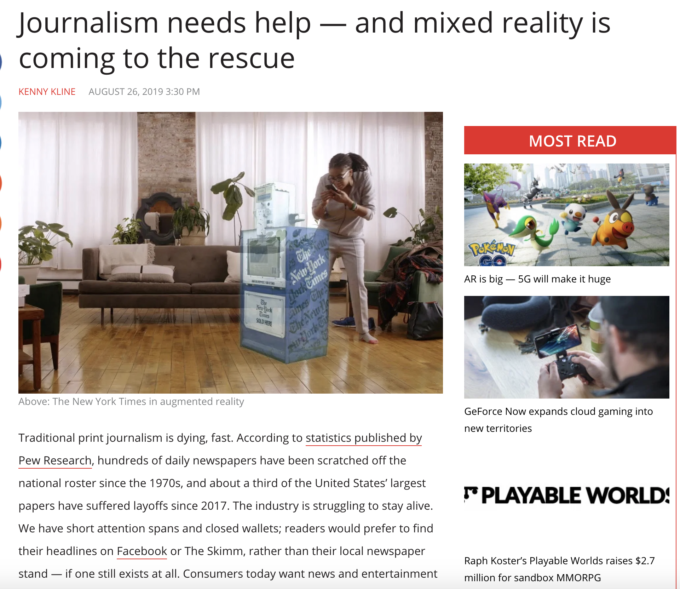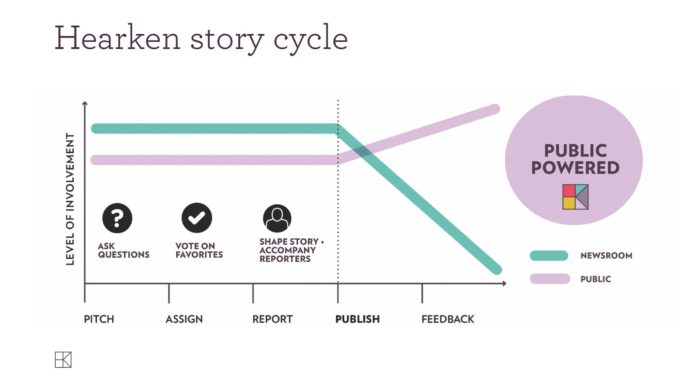When you think of the word “journalism”, what comes to mind? A quick skim through Google News sees words like “crisis”, “lie”, and the headline statement, “Journalism needs help”. We don’t necessarily think of “community” when we think of journalism, but maybe we should.

As how we communicate evolves, how we find information and connect with other does as well. As the social, digital, and virtual become more prevalent in our lives, community approaches have become more important in bringing people together in online (and offline) spaces.
Most of us have heard how journalism is dying, but not all of us have heard that journalism is trying something different: community.
Where Journalism Is
If you’ve read any tweet, article, or blog post, you know the drill. Journalism has trust issues. Publications are losing readership and revenue. Technology is shifting and privacy concerns are mounting. None of this is wrong, per se, but this also isn’t the entire story.
Each of these statements is interrelated. Social media users have heard of why they should be concerned about their privacy, so they don’t trust platforms, and, in turn, don’t trust the information on them. In the age of information immediacy, journalists need to pump out information to be first and right, usually sacrificing the latter to get the former. Stories are scooped quickly and spread like wildfire, for better or for worse. A bad story or a piece of wrong information is shared and criticized immediately, damaging a journalist’s, and their publication’s, reputation. With all of this in mind, the public is hesitant to trust and, even more so, hesitant to pay for journalism.
That’s the narrative we’re constantly hearing, but is it the whole truth?
How does journalism go from this storyline to a new one: a storyline where journalism is for the people and maybe even by the people?
How does journalism build trust back and continue to provide a service that the public so desperately needs?
How does journalism go back to its roots: within the fibers of community?
What Journalism Needs
So where does journalism go from where it is now? The answer is toward community. Journalism needs to reach back to its roots and meet people where they are.
Instead of fighting to find the next best thing, journalists need to find their readers, go to them, and create a space for them. Instead of fighting the ever-changing media and technology landscape — either by holding onto the old ways or pushing against the new — journalists need to tell their stories in a way that will reach their readers. Instead of fighting what people want to read and producing what they’re supposed to produce, journalists need to deliver relevant and necessary content.
All of these needs can be fulfilled by simply knowing who these readers are.
A key piece of community strategy is profiling your community members and understanding their motivators, their influencers, and their goals for being there. If journalists go back to this way of thinking, they can set up a foundation from which to build upon.
Why Journalism Should Embrace Community
Community approaches all center around the people, as does journalistic strategy, for, if there are no members or readers, there is no community or journalism. Since these two entities have similar starting places, they stand to learn a lot from each other, as they really aren’t all that different. They just have different outputs.
Some know that community and journalism aren’t all that different, as some journalists have already started implementing community approaches. From the hyperlocal to regional to national, journalistic outlets have leaned into community approaches, putting the person at the center of their cause and structuring how they disseminate information around people’s needs and wants.
In recent years, contributor networks (or publications that provide space for readers to add comments, suggest stories or topics, and give feedback) have become more and more prevalent. These two-way conversations between readers and journalists fulfill the feedback loop and bring readers into the journalistic process, making them a part of the narrative and creating buy-in.
This involvement builds trust and validity through personal connections and allows for readers, or members of these journalism-centered communities, to be a part of the journalism process. Just like in a formal community of practice, community members work together around a common goal. Journalists can take the feedback from their contributors and implement new ideas, take edits into account, or even follow up after the fact.
In a similar fashion, these contributor networks also put a face to the journalist, as they’re a part of the community as well. By engaging in comments, hosting offline events to speak to members of the public, and physically speaking to their readers, journalists create a contributor culture that both keeps readers coming back and builds trust in the process.
Amidst all of the technology shifts and concerns, a key aspect of community and journalism alike is to meet people where they are. In community approaches, a community manager needs to use the tools that work best for their members and, similarly, a journalist needs to share their information and stories where their readers are going to find and connect with them.
By creating an online place where readers can go to engage with a story, the journalist, and other readers, journalists can create a formal feedback loop: engaging with readers online (in social media, on a community platform, on a formal website, etc.) around content and then use that engagement to fuel future stories and reporting. Essentially creating a shared purpose with readers that is to produce well-rounded, publicly-sourced content that is relevant to the entire readership base.
What Journalism is Doing Right
There are already many outlets that are taking these community approaches and integrating them with their journalism strategy, and we keep seeing more emerge.
Organizations like Free Press are working to strengthen the community/journalism relationship to enact change. Projects like the News Voices program (run by Free Press) aim to bring communities and journalists together to shape journalism’s future around community. Getting more specific, some projects, like Voting Block, work to bring local communities together (in events like political potlucks) to speak to both each other and journalists to open dialogue around difficult topics.
Other organizations, like the Membership Puzzle Project, are looking at journalism business and governance models and what will be sustainable moving forward. The Membership Puzzle Project focuses on membership models and how membership drives both revenue and loyalty. On the technology side, Hearken built a “public-powered” model where journalists speak with their readers before publication to produce inclusive, relevant, and timely content. Hearken also created the Engagement Management System technology platform that keeps journalists on that mission while also complementing the traditional journalism administrative tasks (email leads, newsletter & CRM integrations, etc.).
Finally, on a more local level, we’ve seen organizations working hard to create their own communities. One member of TheCR Network joined TheCR’s community of practice because they wanted to get a formal understanding of community approaches before launching their own community within their online publication. After dealing with a loss of readership after print changes and a lack of engagement because of no commenting ability, they’re focusing on meeting people where they are and opening up channels for conversation.
Yes, journalism as a whole might be struggling, but there is so much promise in what the few and mighty are working to do. Many of these may be on a more local level, but they show that journalism can (and probably should) adapt community approaches in order to stay relevant and financially solvent.
If you know of other examples of journalistic outlets utilizing community approaches, let us know!
If you’re implementing that yourself, we’d love to have you in our community for community professionals. We’re always working to advance the community industry and journalism is very much a part of that. Read more about how to join TheCR Network and start bringing more community strategy into the journalism space.

